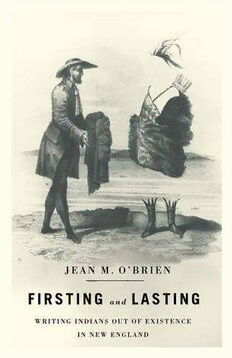
Firsting and Lasting: Writing Indians out of Existence in New England PDF
Preview Firsting and Lasting: Writing Indians out of Existence in New England
FIRSTING AND LASTING Indigenous Americas Robert Warrior and Jace Weaver SERIES EDITORS Raymond D. Austin, Navajo Courts and Navajo Common Law: A Tradition of TribalSelf-Governance Lisa Brooks, The Common Pot: The Recovery of Native Space in the Northeast Kevin Bruyneel, The Third Space of Sovereignty: The Postcolonial Politics of U.S.–Indigenous Relations Daniel Heath Justice, Our Fire Survives the Storm: A Cherokee Literary History Thomas King, The Truth about Stories: A Native Narrative Jean M. O’Brien, Firsting and Lasting: Writing Indians out of Existence in New England Paul Chaat Smith, Everything You Know about Indians Is Wrong Gerald Vizenor, Bear Island: The War at Sugar Point Robert Warrior, The People and the Word: Reading Native Nonfiction Robert A. Williams, Jr., Like a Loaded Weapon: The Rehnquist Court, Indian Rights, and the Legal History of Racism in America FIRSTING AND LASTING Writing Indians out of Existence in New England Jean M. O’Brien Indigenous Americas Series University of Minnesota Press Minneapolis London Portions of chapters 3 and 4 were published in “‘Vanishing’ Indians in Nineteenth-Century New England: Local Historians’ Erasure of Still-Present Indian People,” in Sergei Kan and Pauline Turner Strong, eds., New Perspec- tives on Native North America: Cultures, Histories, and Representations(Lincoln: University of Nebraska Press, 2006), 414–32. Copyright 2010 by the Regents of the University of Minnesota All rights reserved. No part of this publication may be reproduced, stored in a retrieval system, or transmitted, in any form or by any means, electronic, mechanical, photocopying, recording, or otherwise, without the prior written permission of the publisher. Published by the University of Minnesota Press 111 Third Avenue South, Suite 290 Minneapolis, MN 55401-2520 http://www.upress.umn.edu Library of Congress Cataloging-in-Publication Data O’Brien, Jean M. Firsting and lasting : writing Indians out of existence in New England / Jean M. O’Brien. p. cm. — (Indigenous Americas) Includes bibliographical references and index. ISBN 978-0-8166-6577-8 (acid-free paper) — ISBN 978-0-8166-6578-5 (pbk. : acid-free paper) 1. Indians of North America—New England—History—19th century. 2. Indians of North America—New England—Historiography.3. New England—History—19th century.4. New England—Historiography. 5. New England—Race relations. I. Title. E78.N5O35 2010 974'03—dc22 2010003781 Printed in the United States of America on acid-free paper The University of Minnesota is an equal-opportunity educator and employer. 18 17 16 15 14 13 12 11 10 10 9 8 7 6 5 4 3 2 1 For Tim This page intentionally left blank Contents AUTHOR’S NOTE ON SOURCES ix INTRODUCTION Indians Can Never Be Modern xi 1. FIRSTING Local Texts Claim Indian Places As Their Own 1 2. REPLACING Historical Practices Argue That Non-Indians Have Supplanted Indians 55 3. LASTING Texts Purify the Landscape of Indians by Denying Them a Place in Modernity 105 4. RESISTING Claims in Texts about Indian Extinction Fail Even As They Are Being Made 145 CONCLUSION The Continuing Struggle over Recognition 201 ACKNOWLEDGMENTS 207 NOTES 211 INDEX 261 This page intentionally left blank Author’s Note on Sources I used several principles of inclusion and exclusion in identifying the texts on which this book rests. I started by creating a comprehensive bibliography of local histories of all the towns and cities of Connecticut, Massachusetts, and Rhode Island published between 1820 and 1880, using the indispensable vol- umes produced by the Committee for a New England Bibliography.1I decided not to confine my search solely to volumes that announced themselves as his- tories of particular localities in single or multivolume form, but also included pamphlets that contained historical orations, Fourth of July orations, publi- cations that grew out of local commemorations, and the like. I included in my bibliography the few items I found that were published before 1820, and I added some texts published after 1880, especially if there were no other texts available for that particular town, for places located near nineteenth- century Indian communities, or if the titles intrigued me. Once I settled down to read the texts I noticed some patterns and further modified my list. Fairly early on I concluded, for example, that church histo- ries, manuals, and anniversaries rarely included Indians; sermons or histori- cal discourses delivered at churches also likely did not. I did include some of these, but for the most part I omitted them from consideration. I excluded genealogies (no real narratives there, except the implicit argument of the depth of non-Indian lineages in particular places); newspaper, journal, and periodical literature (far too much of it, usually topically aimed); publications devoted to topical themes that weren’t likely to include Indians (for example, a history of the copper mines in Granby, Connecticut); histories of wars, unless they involved Indians (I discovered early that even accounts of the Boston Massacre, in which Crispus Attucks was killed, did not talk much about his Native descent); missionary histories, specifically Indian mission- ary histories (of course they include Indians); and the dedication of buildings (although I did include a few of these). ix
